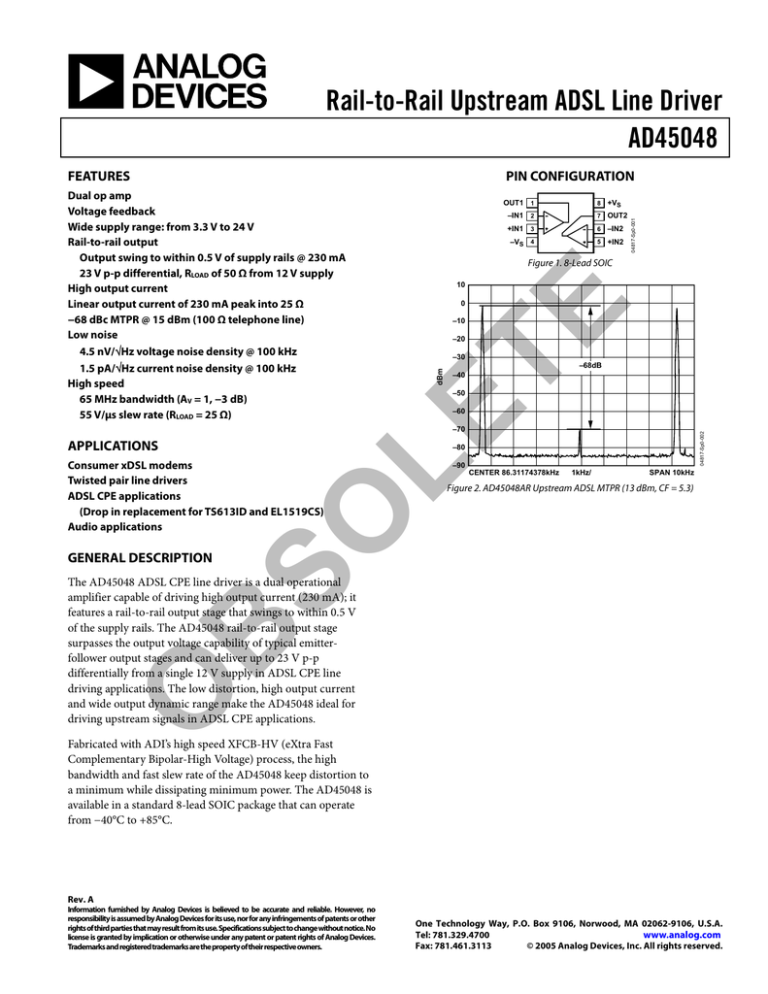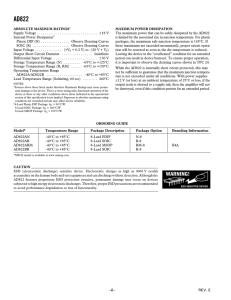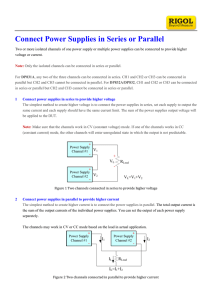
Rail-to-Rail Upstream ADSL Line Driver
AD45048
PIN CONFIGURATION
OUT1 1
8
+VS
–IN1 2
7
OUT2
+IN1 3
6
–IN2
–VS 4
5
+IN2
Figure 1. 8-Lead SOIC
10
TE
0
–10
–20
dBm
–30
–68dB
–40
–50
LE
Dual op amp
Voltage feedback
Wide supply range: from 3.3 V to 24 V
Rail-to-rail output
Output swing to within 0.5 V of supply rails @ 230 mA
23 V p-p differential, RLOAD of 50 Ω from 12 V supply
High output current
Linear output current of 230 mA peak into 25 Ω
−68 dBc MTPR @ 15 dBm (100 Ω telephone line)
Low noise
4.5 nV/√Hz voltage noise density @ 100 kHz
1.5 pA/√Hz current noise density @ 100 kHz
High speed
65 MHz bandwidth (AV = 1, −3 dB)
55 V/μs slew rate (RLOAD = 25 Ω)
04817-Sp0-001
FEATURES
–60
–80
–90
CENTER 86.31174378kHz
1kHz/
SPAN 10kHz
Figure 2. AD45048AR Upstream ADSL MTPR (13 dBm, CF = 5.3)
B
SO
Consumer xDSL modems
Twisted pair line drivers
ADSL CPE applications
(Drop in replacement for TS613ID and EL1519CS)
Audio applications
04817-Sp0-002
–70
APPLICATIONS
GENERAL DESCRIPTION
O
The AD45048 ADSL CPE line driver is a dual operational
amplifier capable of driving high output current (230 mA); it
features a rail-to-rail output stage that swings to within 0.5 V
of the supply rails. The AD45048 rail-to-rail output stage
surpasses the output voltage capability of typical emitterfollower output stages and can deliver up to 23 V p-p
differentially from a single 12 V supply in ADSL CPE line
driving applications. The low distortion, high output current
and wide output dynamic range make the AD45048 ideal for
driving upstream signals in ADSL CPE applications.
Fabricated with ADI’s high speed XFCB-HV (eXtra Fast
Complementary Bipolar-High Voltage) process, the high
bandwidth and fast slew rate of the AD45048 keep distortion to
a minimum while dissipating minimum power. The AD45048 is
available in a standard 8-lead SOIC package that can operate
from −40°C to +85°C.
Rev. A
Information furnished by Analog Devices is believed to be accurate and reliable. However, no
responsibility is assumed by Analog Devices for its use, nor for any infringements of patents or other
rights of third parties that may result from its use. Specifications subject to change without notice. No
license is granted by implication or otherwise under any patent or patent rights of Analog Devices.
Trademarks and registered trademarks are the property of their respective owners.
One Technology Way, P.O. Box 9106, Norwood, MA 02062-9106, U.S.A.
Tel: 781.329.4700
www.analog.com
Fax: 781.461.3113
© 2005 Analog Devices, Inc. All rights reserved.
AD45048
TABLE OF CONTENTS
General Description..........................................................................7
Applications....................................................................................... 1
Power Supply and Decoupling.....................................................7
General Description ......................................................................... 1
Layout Considerations..................................................................7
Pin Configuration............................................................................. 1
CPE ADSL Application ................................................................7
Revision History ............................................................................... 2
Transformer Selection ..................................................................7
Specifications..................................................................................... 3
Receive Channel Considerations.................................................7
Absolute Maximum Ratings............................................................ 4
Outline Dimensions ..........................................................................8
ESD Caution.................................................................................. 4
Ordering Guide .............................................................................8
Typical Performance Characteristics ............................................. 5
REVISION HISTORY
O
B
SO
7/04—Revision 0: Initial Version
LE
9/05—Rev. 0 to Rev. A
Updated Outline Dimensions ......................................................... 8
Changes to Ordering Guide ............................................................ 8
TE
Features .............................................................................................. 1
Rev. A | Page 2 of 8
AD45048
SPECIFICATIONS
VS = ±6 V or +12 V (@ TA = 25°C, G = +10, RL = 100 Ω, unless otherwise noted).
Table 1.
Test Conditions/Comments
fC = 40 kHz, VOUT = 6 V p-p, single-ended, RLOAD = 25 Ω
26 kHz to 134 kHz, ZLINE = 100 Ω, XFMR = 1:2 turns, PLINE = 13 dBm
f = 100 kHz
f = 100 kHz
−80
−68
4.5
1.5
dBc
dBc
nV/√Hz
pA/√Hz
LE
f = 100 kHz
B
SO
O
Unit
MHz
MHz
MHz
V/μs
TMIN − TMAX
Differential Output Voltage Swing
Single-Ended +Swing
Single-Ended -Swing
Single-Ended +Swing
Single-Ended –Swing
Operating Range (Dual Supply)
Supply Current
Power Supply Rejection Ratio
Common-Mode Rejection Ratio
Max
65
3.35
4.5
55
Input Offset Voltage Match
Input Bias Current
OUTPUT CHARACTERISTICS
Output Resistance
Output Voltage Swing
Typ
G = +1, VOUT = 0.1 V p-p, RFB = 0 Ω, RLOAD = 25 Ω
VOUT = 0.1 V p-p single-ended, G = +1, RLOAD = 25 Ω
VOUT = 1 V p-p single-ended, G = +10, RLOAD = 25 Ω
VOUT = 5 V p-p, G = +1, RLOAD = 25 Ω
TMIN − TMAX
Input Offset Current
Open-Loop Gain
INPUT CHARACTERISTICS
Input Resistance
Input Capacitance
Min
TE
Parameter
DYNAMIC PERFORMANCE
−3 dB Bandwidth
0.1 dB Flatness
Large Signal Bandwidth
Large Signal Slew Rate
NOISE/DISTORTION PERFORMANCE
Distortion (Worst Harmonic)
Multitone Power Ratio
Input Voltage Noise
Input Current Noise
DC PERFORMANCE
Input Offset Voltage
1.4 MHz; G = +1
Maximum swing (differential) VOMAX, RLOAD = 50 Ω differential
Minimum swing (differential) VOMIN, RLOAD = 50 Ω differential
ΔVOUT = VOMAX − VOMIN
RLOAD = 25 Ω
RLOAD = 25 Ω
RLOAD = 100 Ω
RLOAD = 100 Ω
±0.5 V
±1 V
Rev. A | Page 3 of 8
85
11.25
22.5
5.68
5.92
±1.5
7
1
2.5
1
200
1.3
50
94
2.5
2.0
900
300
mV
mV
mV
nA
μA
nA
dB
87
1.4
kΩ
pF
0.2
11.5
−11.5
23
5.76
−5.67
5.95
−5.91
Ω
V diff
V diff
V p-p
Vp
Vp
Vp
Vp
V
mA
dB
dB
9
−85
−86
−11.25
−5.58
−5.86
±12.6
12
−75
−79
AD45048
ABSOLUTE MAXIMUM RATINGS
Table 2.
Rating
26.4 V
(TJMAX – TA)/θJA 1
−65°C to +125°C
−40°C to +85°C
300°C
150°C
Stresses above those listed under Absolute Maximum Ratings
may cause permanent damage to the device. This is a stress
rating only; functional operation of the device at these or any
other conditions above those indicated in the operational
section of this specification is not implied. Exposure to absolute
maximum rating conditions for extended periods may affect
device reliability.
1
θJA = 112.7°C/W for SOIC package in still air based on 2S2P JEDEC PCB.
TE
Parameter
Supply Voltage
Power Dissipation
Storage Temperature
Operating Temperature Range
Lead Temperature Range
(Soldering 10 sec)
Junction Temperature
ESD CAUTION
O
B
SO
LE
ESD (electrostatic discharge) sensitive device. Electrostatic charges as high as 4000 V readily accumulate
on the human body and test equipment and can discharge without detection. Although this product features
proprietary ESD protection circuitry, permanent damage may occur on devices subjected to high energy
electrostatic discharges. Therefore, proper ESD precautions are recommended to avoid performance
degradation or loss of functionality.
Rev. A | Page 4 of 8
AD45048
TYPICAL PERFORMANCE CHARACTERISTICS
25
–
G = +5
25Ω
G = +2
–5
G = +1
0
–5
–10
–10
–15
–15
1M
10M
FREQUENCY (Hz)
100M
1G
Figure 3. Noninverting Small Signal Bandwidth
(VS = ±6 V, VO = 0.1 V p-p, RL = 25 Ω)
RG
G = –5
1M
10M
FREQUENCY (Hz)
100M
25
5kΩ
G = –10
20
–
RG
G = –5
15
+
–
+
25Ω
10
–10
–15
–20
–25
10k
04817-Sp0-025
–5
100k
1M
10M
FREQUENCY (Hz)
100M
1G
G = –1
0
–5
–10
–15
–20
–25
10k
Figure 4. Inverting Small Signal Bandwidth
(VS = ±6 V, VO = 0.1 V p-p, RL = 25 Ω)
O
–40
100k
1M
10M
FREQUENCY (Hz)
100M
R2
3kΩ
+12V
R1
499Ω
+VIN
2
8
V+
3
–60
4.7μF
TANT
0.1μF
OUT
1
R3
12.5Ω
U1A
TX1
AD45048
R3
100Ω
+6V
5
04817-Sp0-027
–70
–80
0
5
10
dBm (100Ω)
1G
Figure 7. Inverting Large Signal Bandwidth
(VS = ±6 V, VO = 1 V p-p, RL = 25 Ω)
–50
MTPR
G = –2
5
GAIN (dB)
G = –1
0
B
SO
GAIN (dB)
G = –2
5
25Ω
04817-Sp0-018
10
1G
Figure 6. Noninverting Large Signal Bandwidth
(VS = ±6 V, VO = 1 V p-p, RL = 25 Ω)
5kΩ
G = –10
100k
LE
25
–25
10k
15
20
Figure 5. MTPR vs. Line Power (See Schematic in Figure 8)
–VIN
R4
499Ω
OUT
6
7
R6
12.5Ω
V–
U1B
4 AD45048
R5
3kΩ
Figure 8. Differential Test Circuit for MTPR
Rev. A | Page 5 of 8
1:2
04817-Sp0-014
100k
–20
TE
–20
04817-Sp0-026
0
15
25Ω
5
GAIN (dB)
G = +1
20
+
G = +2
5
–25
10k
–
10
04817-Sp0-017
GAIN (dB)
10
RG
G = +5
15
+
499Ω
G = +10
20
RG
15
25
499Ω
G = +10
20
AD45048
10
100
1k
10k
100k
FREQUENCY (Hz)
1M
10M
Figure 9. Voltage Noise vs. Frequency, VS = ±6 V
100
1k
10k
100k
FREQUENCY (Hz)
1M
10M
Figure 12. Input Current Noise vs. Frequency, VS = ±6 V
0
1000
–20
–60
SECOND
–80
04817-Sp0-028
–100
THIRD
–120
1
2
3
4
5
6
7
8
OUTPUT VOLTAGE (p-p)
9
10
11
1
0.1
0.01
0.001
10k
100k
1M
10M
FREQUENCY (Hz)
100M
Figure 13. Output Impedance vs. Frequency
2V/DIV
04817-Sp0-031
04817-Sp0-029
O
Figure 10. Single-Ended Harmonic Distortion, VS = ±6 V dc, G = +6,
RF = 499 Ω, RG = 100 Ω, RL = 25 Ω, Fundamental Frequency = 40 kHz
10
04817-Sp0-030
–40
OUTPUT IMDEDANCE (Ω)
LE
100
B
SO
DISTORTION (dBc)
1
10
100M
TE
1
10
10
04817-Sp0-020
CURRENT NOISE (pA/ Hz)
100
04817-Sp0-019
VOLTAGE NOISE (nV/ Hz)
100
50mV/DIV
M 5.00μs
M 100ns
Figure 11. Discrete Multitone Modulation Overdrive Recovery
(See Schematic in Figure 8)
Figure 14. Small Signal Pulse Response RLOAD = 1 kΩ, RFB = 500 Ω
Rev. A | Page 6 of 8
AD45048
GENERAL DESCRIPTION
The AD45048 is a voltage feedback, rail-to-rail output amplifier
with high output current capability. Fabricated on Analog
Devices’ proprietary high speed eXtra fast complementary
bipolar high voltage process (XFCB-HV), the high bandwidth
and fast slew rate of the AD45048 keep distortion to a
minimum while dissipating minimum power. The XFCB-HV,
silicon-on-insulator (SOI) process prevents latch-up problems
and enables the construction of high frequency, low distortion
amplifiers, such as the AD45048.
CPE ADSL APPLICATION
The low cost, high output current dual AD45048 xDSL line
driver amplifiers have been specifically designed to drive high
fidelity xDSL signals to within 0.5 V of the power rails on a
single 12 V supply. The AD45048 can be used in transformercoupled bridge hybrid circuits designed to drive modulated
signals, including discrete multitone (DMT), upstream to the
central office.
TRANSFORMER SELECTION
Customer premise ADSL applications require the transmission
of a 13 dBm DMT signal (20 mW into 100 Ω). DMT signals can
have a crest factor (V peak/V rms ratio) as high as 5.3, requiring
the line driver to provide a peak power of 560 mW. The line
driver is required to drive a 7.5 V peak onto the 100 Ω
telephone line while maintaining about −65 dBc to −70 dBc of
MTPR. Since the maximum low distortion output swing
available from the AD45048 line driver is approximately 11.5 V
on a 12 V supply (depending on the load), and taking into
account the power lost in the transformer and termination
resistors, a step-up transformer with a minimum turns ratio of
1.5 or greater is needed. In the simplified differential driver
circuit shown in Figure 8, the AD45048 is driving a 25 Ω
impedance reflected by 1:2 step-up transformer. R3 and R6 are
12.5 Ω each and are back-termination or load-matching
resistors whose values can be calculated by
B
SO
LE
The AD45048 can be powered with a good quality, well
regulated, low noise supply anywhere in the range from +3 V to
±12.6 V. In order to optimize the AD45048 in standard ADSL
CPE line driver applications (see Figure 8), power the amplifier
with a well regulated 12 V supply. Careful attention should be
paid to decoupling the power supply. High quality capacitors
with low equivalent series resistance (ESR), such as multilayer
ceramic capacitors (MLCCs), should be used to minimize the
supply voltage ripple and power dissipation. A 0.1 μF MLCC
decoupling capacitor(s) should be located no more than
1/8-inch away from the power supply pin(s). A large, usually
tantalum, 10 μF to 47 μF capacitor is recommended to provide
good decoupling for lower frequency signals and to supply
current for fast, large signal changes at the AD45048 outputs.
TE
POWER SUPPLY AND DECOUPLING
LAYOUT CONSIDERATIONS
O
As is the case with all high speed applications, careful attention
to printed circuit board layout details prevents associated board
parasitics from becoming problematic. Proper RF layout and
printed circuit board design techniques are strongly
recommended. The PCB should have a low impedance return
path (or ground) to the supply. Removing the ground plane
from all layers in the immediate area of the amplifier reduces
stray capacitances. The signal routing should be short and
direct in order to minimize the parasitic inductance and
capacitance associated with these traces. Termination resistors
and loads should be located as close as possible to their
respective inputs and outputs. Input traces should be kept as far
apart as possible from the output traces to minimize coupling
(crosstalk) though the board.
Wherever there are complementary signals, a symmetrical
layout should be provided to the extent possible in order to
maximize balanced performance. When running differential
signals over a long distance, the traces on the PCB should be
close together or any differential wiring should be twisted
together to minimize the area of the loop that is formed. This
reduces the radiated energy and makes the circuit less
susceptible to RF interference. Adherence to stripline design
techniques for long signal traces (greater than about 1 inch) is
recommended.
(100 Ω/(N2))/2
where 100 Ω is the approximate phone line impedance and N is
the transformer turns ratio. In Figure 8, the total differential
load including the termination resistors is 50 Ω, and under
these conditions, the AD45048 is capable of driving low
distortion signals to within 0.5 V of the power rails.
RECEIVE CHANNEL CONSIDERATIONS
A step-up transformer of N turns used at the output of the
differential line driver increases the differential output voltage
to the line (see Figure 8). However, the inverse effect is seen in
the receive channel as the amplitude of signal on the driver side
of the transformer is divided by N turns. The decision to use a
particular transformer turns ratio may be impacted by the
ability of the receive circuitry to resolve low level signals in the
noisy twisted pair telephone plant. Higher turns ratio
transformers reduce the effective receive channel SNR (signalto-noise ratio) due to the reduction in the received signal
strength.
An amplifier with low RTI noise, such as the AD8022
(2.5 nV/√Hz), is recommended for the receive channel. For a
complete selection of amplifiers and other related components,
see www.analog.com.
Rev. A | Page 7 of 8
AD45048
OUTLINE DIMENSIONS
5.00 (0.1968)
4.80 (0.1890)
5
6.20 (0.2440)
4 5.80 (0.2284)
1.27 (0.0500)
BSC
0.25 (0.0098)
0.10 (0.0040)
1.75 (0.0688)
1.35 (0.0532)
0.51 (0.0201)
COPLANARITY
SEATING 0.31 (0.0122)
0.10
PLANE
0.50 (0.0196)
× 45°
0.25 (0.0099)
8°
0.25 (0.0098) 0° 1.27 (0.0500)
0.40 (0.0157)
0.17 (0.0067)
TE
8
4.00 (0.1574)
3.80 (0.1497) 1
COMPLIANT TO JEDEC STANDARDS MS-012-AA
CONTROLLING DIMENSIONS ARE IN MILLIMETERS; INCH DIMENSIONS
(IN PARENTHESES) ARE ROUNDED-OFF MILLIMETER EQUIVALENTS FOR
REFERENCE ONLY AND ARE NOT APPROPRIATE FOR USE IN DESIGN
ORDERING GUIDE
Z = Pb-free part.
Package Description
8-Lead Standard Small Outline Package (SOIC_N)
8-Lead Standard Small Outline Package (SOIC_N)
8-Lead Standard Small Outline Package (SOIC_N)
8-Lead Standard Small Outline Package (SOIC_N)
8-Lead Standard Small Outline Package (SOIC_N)
8-Lead Standard Small Outline Package (SOIC_N)
O
1
Temperature Range
−40°C to +85°C
−40°C to +85°C
−40°C to +85°C
−40°C to +85°C
−40°C to +85°C
−40°C to +85°C
B
SO
Model
AD45048AR
AD45048AR-REEL
AD45048AR-REEL7
AD45048ARZ 1
AD45048ARZ-REEL1
AD45048ARZ-REEL71
LE
Figure 15. 8-Lead Standard Small Outline Package [SOIC_N]
Narrow Body (R-8)
Dimensions shown in millimeters and (inches)
© 2005 Analog Devices, Inc. All rights reserved. Trademarks and
registered trademarks are the property of their respective owners.
D04817–0–9/05(A)
Rev. A | Page 8 of 8
Package Option
R-8
R-8
R-8
R-8
R-8
R-8





